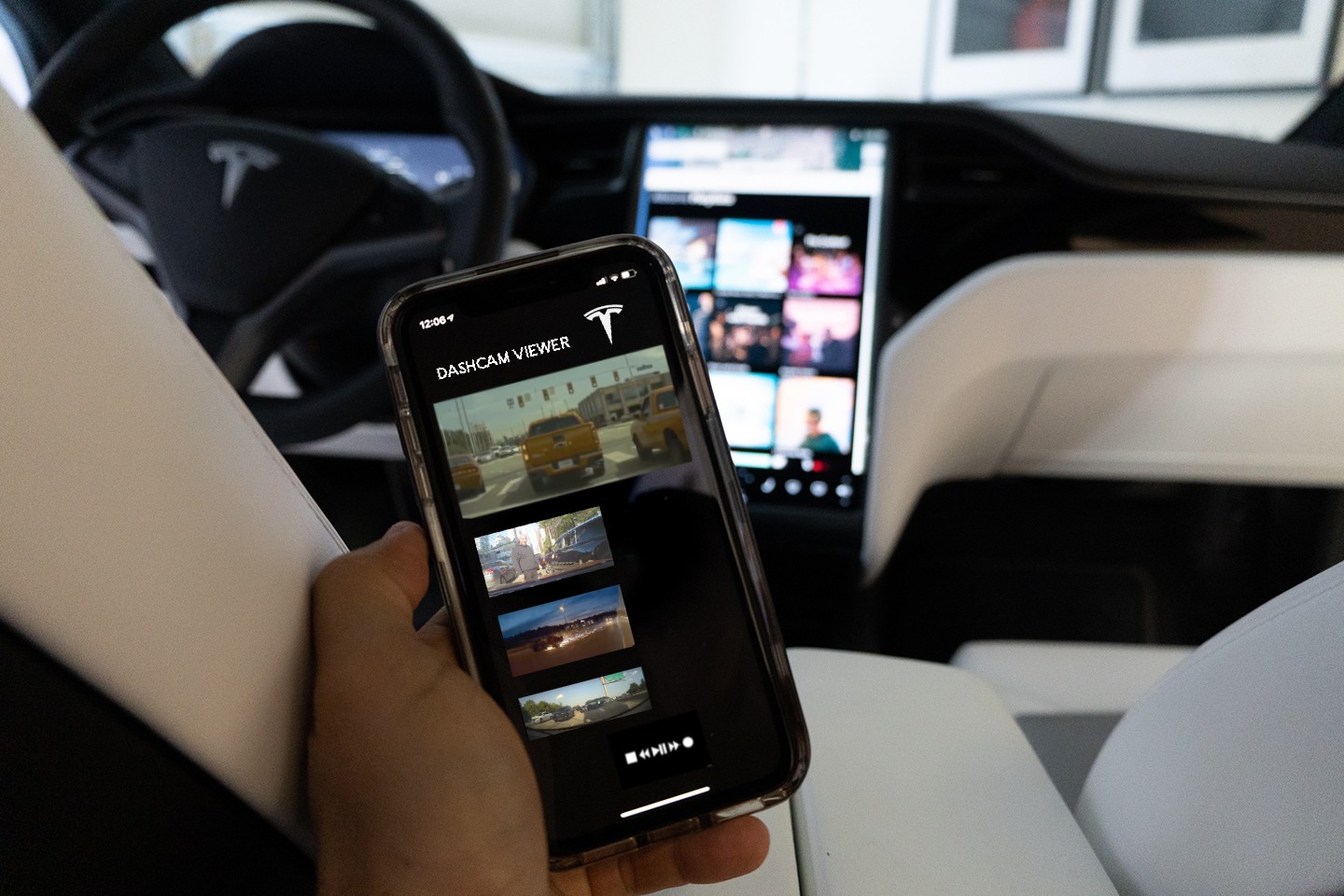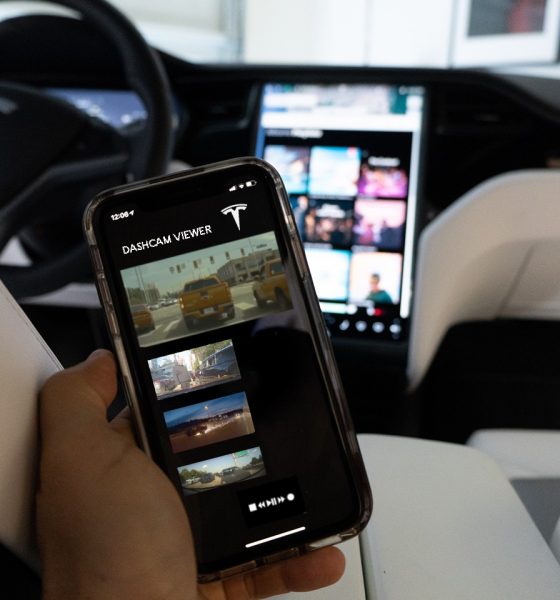

Lifestyle
Tesla “Dashcam Viewer” opens doors to Mobile App integration for remote video viewing
Tesla’s introduction of the “Dashcam Viewer” feature was groundbreaking for many reasons, but how great would it be to have the feature in its mobile app?
The previous viewing experience for watching recorded clips from Sentry or Dashcam required the tedious steps to download footage from a memory card and into a computer. With the latest over-the-air software update, Tesla owners can view recorded clips directly on the vehicle’s large center touchscreen. However, there are reasons that Tesla should take this feature a step further and take a baby cam or webcam approach by extending the video-viewing experience to the Tesla mobile app.
After all, the company already has the capability to upload Sentry Mode video clips into the company’s “cloud” infrastructure, thereby having a platform that could make viewing of video clips from any internet-capable device a possibility. In addition, the service to be able to monitor events captured by the vehicle’s onboard cameras becomes an added-value to Tesla’s Premium Connectivity service and increasing revenue stream from subscribers to the monthly plan.
Many companies whose products use cameras have integrated in-app viewing for ease of access for users. For example, home security systems manufactured by Nest have allowed homeowners to view instances of burglary within their homes on smartphones, allowing the victims of a home invasion the ability to report a theft in progress quickly. The recorded clips can also help police identify suspects, which could lead to an arrest or even the recovery of stolen goods. This feature would be ideal for vehicles involved in burglaries or accidents.
In the event of an accident, some dash screens or vehicle computers are damaged or compromised because of the collision. Unfortunately, this could inhibit the driver’s ability to show footage of the accident to police officers or insurance agents. It is more likely that a phone would survive an accident if it was placed in a driver’s pocket or one of the vehicle’s storage compartments, like a center console. A phone viewer would make viewing the clips or showing them to the proper authorities, an easier process as the phone could be readily available if the vehicle’s touchscreen or onboard hardware is malfunctioning after an accident.
Additionally, the quickly available clip of the accident could lead to police accurately describing an accident on a report. It is, unfortunately, a common occurrence for people who are involved in accidents to be falsely accused of causing the issue on the road. These incorrect reports can lead to hiked insurance rates and lengthy battles to have vehicles repaired. Quick and painless access to a clip of the accident could fix this issue altogether.
While advantageous for owners and drivers, Tesla could benefit financially from the additional feature. In early December, Tesla announced its “Premium Connectivity” feature would no longer be complimentary, and it would cost any owners who purchased their vehicles on or after July 1, 2018, a $9.99 monthly fee. Premium Connectivity allows owners to access certain vehicle features, including live traffic visualization, satellite-view maps, and in-car video streaming services such as Netflix and Youtube (when not connected to Wi-Fi.)
The addition of in-app viewing could lead to more owners subscribing to the Premium Connectivity service. Vehicles will have to use data providers, like AT&T, to stay linked to the cloud-like service. This data connectivity will allow the vehicle to upload saved clips, making them viewable on the Tesla app.
If Tesla decides to add an in-app clip viewer, it could prove to be one of the biggest additions the company makes to its smartphone application. Owners have posted videos of the in-car Dashcam Viewer in use, so it seems many people have been awaiting the feature for a long time. Tesla could decide to take the feature just one step further by adding clip viewing to its phone application, making life even easier for vehicle owners.

Lifestyle
Tesla Model S Plaid battles China’s 1500 hp monster Nurburgring monster, with surprising results
There is just something about Tesla’s tuning and refinement that makes raw specs seem not as game-changing.

The Tesla Model S Plaid has been around for some time. Today, it is no longer the world’s quickest four-door electric sedan, nor is it the most powerful. As per a recent video from motoring YouTube channel Carwow, however, it seems like the Model S Plaid is still more than a match for some of its newer and more powerful rivals.
The monster from China
The Xiaomi SU7 Ultra is nothing short of a monster. Just like the Model S Plaid, it features three motors. It also has 1,548 hp and 1,770 Nm of torque. It’s All Wheel Drive and weighs a hefty 2,360 kg. The vehicle, which costs just about the equivalent of £55,000, has been recorded setting an insane 7:04.957 at the Nurburgring, surpassing the previous record held by the Porsche Taycan Turbo GT.
For all intents and purposes, the Model S Plaid looked outgunned in Carwow’s test. The Model S Plaid is no slouch with its three motors that produce 1,020 hp and 1,420 Nm of torque. It’s also a bit lighter at 2,190 kg despite its larger size. However, as the Carwow host pointed out, the Model S Plaid holds a 7:25.231 record in the Nurburgring. Compared to the Xiaomi SU7 Ultra’s record, the Model S Plaid’s lap time is notably slower.
Real-world tests
As could be seen in Carwow’s drag races, however, Tesla’s tech wizardry with the Model S Plaid is still hard to beat. The two vehicles competed in nine races, and the older Model S Plaid actually beat its newer, more powerful counterpart from China several times. At one point in the race, the Xiaomi SU7 Ultra hit its power limit due to its battery’s temperature, but the Model S Plaid was still going strong.
The Model S Plaid was first teased five years ago, in September 2020 during Tesla’s Battery Day. Since then, cars like the Lucid Air Sapphire and the Xiaomi SU7 Ultra have been released, surpassing its specs. But just like the Model Y ended up being the better all-rounder compared to the BYD Sealion 7 and the MG IM6, there is just something about Tesla’s tuning and refinement that makes raw specs seem not as game-changing.
Check out Carwow’s Model S Plaid vs Xiaomi SU7 drag race video below.
Lifestyle
500-mile test proves why Tesla Model Y still humiliates rivals in Europe
On paper, the BYD Sealion 7 and MG IM6 promised standout capabilities against the Model Y.

BYD is seeing a lot of momentum in Europe, so much so that mainstream media has taken every opportunity to argue that the Chinese automaker has beaten Tesla in the region. But while BYD sales this year in Europe are rising and Tesla’s registrations remain challenged, the raw capabilities of vehicles like the Model Y are difficult to deny.
This was highlighted in a 500-mile challenge by What Car? magazine, which showed that the new Tesla Model Y is more efficient, cheaper to run, and more reliable than rivals like the BYD Sealion 7, and even the nearly 400 KW-charging MG IM6.
Range and charging promises
On paper, the BYD Sealion 7 and MG IM6 promised standout capabilities against the Model Y. The Sealion 7 had more estimated range and the IM6 promised significantly faster charging. When faced with real-world conditions, however, it was still the Model Y that proved superior.
During the 500-mile test, the BYD nearly failed to reach a charging stop, arriving with less range than its display projected, as noted in a CarUp report. MG fared better, but its charging speeds never reached its promised nearly-400 kW charging speed. Tesla’s Model Y, by comparison, managed energy calculations precisely and arrived at each stop without issue.
Tesla leads in areas that matter
Charging times from 25% to 80% showed that the MG was the fastest at 17 minutes, while Tesla and BYD were close at 28 and 29 minutes, respectively. Overall efficiency and cost told a different story, however. The Model Y consumed 19.4 kWh per 100 km, compared to 22.2 for MG and 23.9 for BYD. Over the full trip, Tesla’s charging costs totaled just £82 thanks to its supercharger network, far below BYD’s £130 and MG’s £119.
What Car? Magazine’s testers concluded that despite BYD’s rapid sales growth and the MG IM6’s seriously impressive charging speeds, Tesla remains the more compelling real-world choice. The Model Y just offers stability, efficiency, and a proven charging infrastructure through its Supercharging network. And as per the magazine’s hosts, the Model Y is even the cheapest car to own among the three that were tested.
Watch What Car? Magazine’s 500-mile test in the video below.
Lifestyle
Tesla Cybertruck slapped with world’s least intimidating ticket, and it’s pure cringe
One cannot help but cringe and feel second-hand embarrassment at the idea of a person just driving around with a stack of these babies.

A Cybertruck parked at Stanford Shopping Center in California was recently hit with what might be the most try-hard piece of paper ever slipped under a wiper blade: a “fake citation” accusing the driver of supporting a “fascist car.”
The note, shared on X by Tesla staff program manager Ryan Torres, quickly made the rounds on X, where it quickly gained attention as an example of how not to protest.
The world’s least intimidating ticket
According to the citation, the supposed “violation” was “driving a fascist car.” The remedial action? Take the bus, call an Uber, or ride a bike. The note also dubbed Elon Musk a “chainsaw-wielding Nazi billionaire.” Now, protests against Tesla and Elon Musk have become commonplace this year, but one cannot help but cringe and feel second-hand embarrassment at the idea of a person just driving around with a stack of fake anti-Tesla/Musk citations.
Torres pointed out the irony himself in his post on X. Tesla currently employs over 140,000 Americans, and SpaceX has put the U.S. firmly back at the top of space technology. As Torres put it, maybe the person behind the world’s least intimidating ticket should “read a book on innovation before vandalizing” other people’s property.
Peak performative clownery
Not to mention that the fake ticket’s logic collapses under its own weight. EVs like the Cybertruck are literally designed to reduce emissions, not “destroy the economy.” If anything, Tesla has bolstered the United States’ economy by fueling jobs in engineering, manufacturing, and clean energy. It’s not the first time a Tesla has been the target of vandalism or politically charged notes, but this one stands out for sheer cringe value.
Torres summed it up neatly: “Peak clownery.” On that point, at least, the citation earns full marks. In a way, though, perhaps cringe fake tickets are not as bad as the literal firebombs that were being thrown at Tesla stores and cars earlier this year because some critics were gleefully misinformed about Elon Musk.









